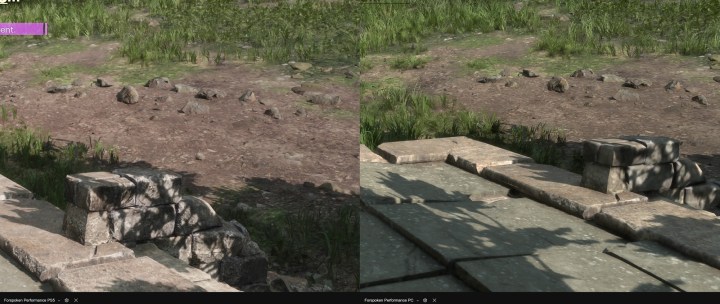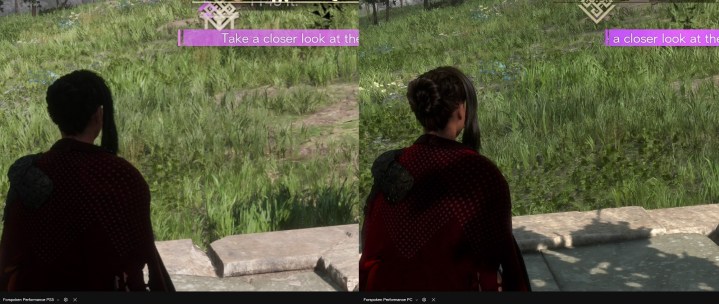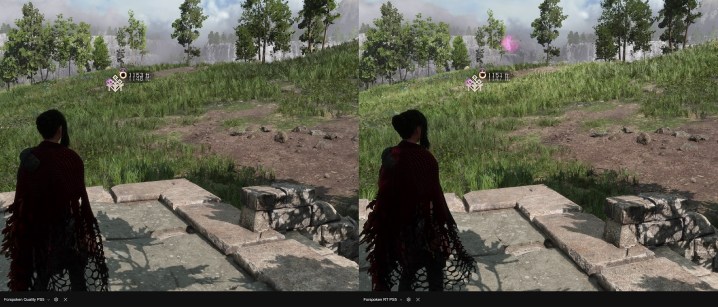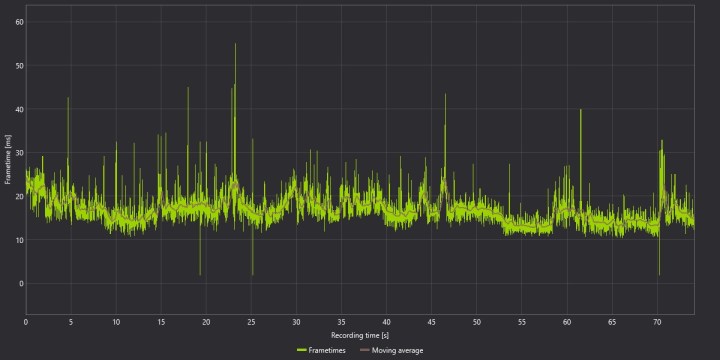I’ll almost always recommend a PC release over a console release. You have access to more graphics options, more opportunities to optimize your performance, and a community-driven support system for modifying or repairing your games. That’s especially true as the current generation of consoles begin to show their age.
But there is still an unsung advantage of playing games on console over a PC, and Square Enix’s Forspoken brings that advantage the PS5 has over PC into the spotlight.
Forspoken on PS5
Starting with the PS5 version, you have access to three performance modes: Quality, Performance, and Ray Tracing. Quality has a variable frame rate that never went below 30 frames per second (fps) in my testing. Ray Tracing also has a variable frame rate that hovers around 30 fps and includes ray-traced shadows, but not ambient occlusion or reflections. Finally, Performance mode attempts to lock the game to 60 fps, occasionally dipping to around 55 fps, and lowers the resolution and draw distance.
For resolution, the game uses dynamic resolution to attempt to keep the frame rate consistent. It hovers between 4K and 1440p, with Performance mode going closer to 1440p and Quality mode closer to 4K. These resolution differences can have a big impact on the look of the game, too.
In particular, the Ray Tracing mode has some significant artifacts as it tries to reconstruct a 4K image. This is by far the weakest mode, not only because of the aggressive upscaling, but also because of the minimal visual impact of ray tracing in Forspoken (more on that in the next section).
Outside of the quality modes, Forspoken also includes a 120Hz mode, but it’s a bit deceptive. This limits the resolution, but the game doesn’t actually reach 120 fps. Instead, it just outputs a 120Hz signal and uses that to achieve 40 fps in the Quality and Ray Tracing modes (usually unsuccessfully).
Forspoken: PC versus PS5
For testing, I used a PC equipped with a Ryzen 5 5600X and AMD RX 6600 XT graphics card. This machine is more expensive than a PS5, but it’s around the same power. You can watch the video above to see how it stacks up overall.
In place of the dynamic resolution in the PS5 version, I used AMD’s FidelityFX Super Resolution 2 (FSR 2) for the Performance and Ray Tracing comparisons. I also kept the game on the Standard graphics preset, which brought up some interesting differences between the PC and PS5 versions.

The PC version looks worse at first glance. The PS5 version looks like it prioritizes textures closer to the camera and uses an enhanced version of those textures. You can see the massive difference in the quality of the stone above, with the PC version looking far less detailed.

These enhanced textures are available in the PC port at higher quality levels, but it exposes how the PS5 version handles them differently. In this same scene, you can see how much softer the edges are around Frey on the PS5. In addition, the grass is blurry in the PS5 version while it’s clear on PC.
On the performance front, FSR 2 does wonders for the PC port with ray tracing turned on, allowing the game to run near 60 fps. Similarly, with ray tracing off, PC is able to maintain 60 fps with FSR 2 turned on to the Balanced mode, while the PS5 occasionally dips a bit lower.
The issue with PC is frame pacing. In the Quality mode, you can see how much stuttering there is despite the average frame rate not being far off the PS5. As I’ll dig into in the next section, the PC port of Forspoken never feels like it’s running smoothly, regardless of how high your frame rate is.

Another big area where the PC and PS5 releases differ is ray tracing. The PS5 supports ray-traced shadows, while the PC version supports shadows and global illumination. Unfortunately, neither does much. There isn’t much of a performance hit, and I struggled to see any difference in image quality.
It’s possible this is a bug right now. Regardless, I recommend keeping ray tracing turned off on PC and PS5.
Major issues with the PC port

There are a couple of major issues with the PC port of Forspoken. First and foremost is frame pacing. As you can see in the performance comparison above, an equivalent PC can reach higher performance than the PS5, but it doesn’t do that consistently.
I didn’t find massive stuttering issues, at least not on the scale of Gotham Knights or Elden Ring. There were a few stutters, but the larger issue was inconsistent frame times. Even with a 60 fps average, the frame time would jump from 16 milliseconds in one moment to over 40ms, and back and forth. Worse is the inconsistent frame rate, so the window for frame time is constantly shifting.
The result is that Forspoken never feels smooth on PC. Even with FSR 2 available, the game never feels consistent. You can improve your frame rate, and the overall performance isn’t bad for lower-end hardware. But even with a tricked-out rig, Forspoken’s average frame rate only tells a fraction of the performance story.

There might be a memory leak in Forspoken, as well. In about an hour of playing, I went from 6GB of memory usage to just over 9GB, and it was a consistent climb. New sections would cause a memory spike before flushing data out, but the baseline usage would move up.
If you’re not familiar with a memory leak, it’s when all the data that’s supposed to be flushed memory isn’t, causing usage to slowly rise the longer you play the game. That could explain why Forspoken calls for 32GB of memory for its recommended system requirements.
It’s easy to show a memory leak, but hard to test the impact. If you don’t have a lot of RAM in your system and play for hours on end, expect the performance to steadily decrease as the RAM usage goes up.
Buy it on PS5
FSR 2 is a huge bump to the PC port of Forspoken, but it’s hard to ignore the possible memory leak and inconsistent frame pacing of the game. The PS5 version runs much smoother, even if it occasionally dips below the target frame rate.
The good news is that the PC version doesn’t have a lot of advantages over the PS5. Ray tracing does next to nothing right now, and although you can achieve higher frame rates, the game still caps out at 120 fps on PC.




